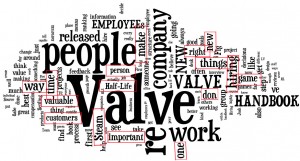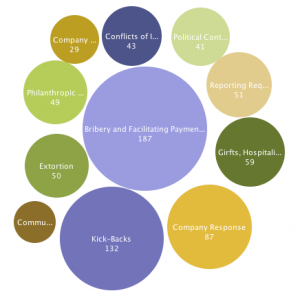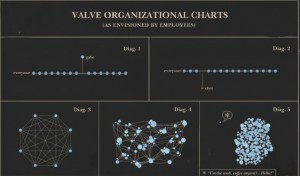For those who haven’t been following, this is the second to last installment in a series of posts where I analyze 5 different video game company policies or codes of conduct. In this series, I examine the connections between the company’s public perception, noted problems with harassment, and the company policies. My final post will include a wrap up of all of these analyses and a more extended discussion of how they fit into my argument. Essentially, my contention is that companies (partly) create their identity through company policies, public policies in particular, and thus we should look to these documents to try at get at the problem of a lack of women in the video game industry. These policies tell stories that manifest symbolically in their employee’s behavior. Thus, change the story, change the behavior (of course it is not nearly that simple, but now you have the gist it).
Unlike many of the companies I’ve discussed so far, Valve has a fairly positive reputation in the gaming community. They have been celebrated for making groundbreaking games like Portal and Portal 2, and have nearly zero bad press for abuse against women or minorities. In fact, one of Valve’s female game developers became known for an article she wrote defending the game industry against claims of sexism based on her positive experience at Valve. She writes, “I have never, however, been treated as anything but a team member and an equal by my coworkers, and it’s a major disservice to them that folks automatically assume they will treat me differently because I am a woman.” [1] Further, their games are not known for depicting women in a sexually demeaning way.
 Given this positive view in the community, and with the correlations we have seen between policy and reputation at other companies like Zynga, one may expect Valve’s policies to be full of statements and codes that protect their employees. This, however, is not the case. In fact, in neither the employee handbook nor the code of conduct is harassment mentioned even once. There is no discussion of equality, harassment, discrimination, or anything that one would expect to find. There is nothing about employee behavior, beyond how to communicate your ideas and work on projects and so forth. They even have a section covering how to make donations to charities with company money. But they never discuss how one should proceed in the event that s/he is being harassed or discriminated against.
Given this positive view in the community, and with the correlations we have seen between policy and reputation at other companies like Zynga, one may expect Valve’s policies to be full of statements and codes that protect their employees. This, however, is not the case. In fact, in neither the employee handbook nor the code of conduct is harassment mentioned even once. There is no discussion of equality, harassment, discrimination, or anything that one would expect to find. There is nothing about employee behavior, beyond how to communicate your ideas and work on projects and so forth. They even have a section covering how to make donations to charities with company money. But they never discuss how one should proceed in the event that s/he is being harassed or discriminated against.
 In each of the two word frequency charts, we can see a somewhat difference emphasis. In the handbook, people, Valve, work, and the company are emphasized. In the code of conduct, technology, engineering, and Valve are emphasized. These seem consistent with the documents I analyzed above from other companies. Despite it being similar on the surface, however, Valve is the only company that does not mention harassment even once. What this means is unclear, and complicated, as there is little evidence that things like harassment and discrimination are a problem at Valve. This could indicate that the culture is so bad that people are afraid to speak out, that things go unreported because there are no clear lines to follow for reporting, that there is not enough diversity for problems to surface, or perhaps there simply are no problems.
In each of the two word frequency charts, we can see a somewhat difference emphasis. In the handbook, people, Valve, work, and the company are emphasized. In the code of conduct, technology, engineering, and Valve are emphasized. These seem consistent with the documents I analyzed above from other companies. Despite it being similar on the surface, however, Valve is the only company that does not mention harassment even once. What this means is unclear, and complicated, as there is little evidence that things like harassment and discrimination are a problem at Valve. This could indicate that the culture is so bad that people are afraid to speak out, that things go unreported because there are no clear lines to follow for reporting, that there is not enough diversity for problems to surface, or perhaps there simply are no problems.
One interesting this Valve does include in their employee handbook is a chart of how employees see the organization being organized.
 As we can see in this chart, Valve has attempted a virtually flat hierarchy. There are no managers or project leads, and no one is the boss. Gabe Newell, the managing director and co-founder, seems to be the only one with a little extra say. In addition to being flat, employees also visualized the structure as a complex web. This could mean a lot of different things. Perhaps this is meant to be a meritocratic organization, though valve never states that. Perhaps this structure makes decisions more visible. Without doing an institutional study, it is not clear how this structure is connected to the company’s reputation or policies. It does, however, raise some interesting and problematic questions.
As we can see in this chart, Valve has attempted a virtually flat hierarchy. There are no managers or project leads, and no one is the boss. Gabe Newell, the managing director and co-founder, seems to be the only one with a little extra say. In addition to being flat, employees also visualized the structure as a complex web. This could mean a lot of different things. Perhaps this is meant to be a meritocratic organization, though valve never states that. Perhaps this structure makes decisions more visible. Without doing an institutional study, it is not clear how this structure is connected to the company’s reputation or policies. It does, however, raise some interesting and problematic questions.
 For example, Emiliio Castilla reports that transparency is one of the most important attributes to have in a company in order to have productive diversity. It seems that this organizational structure could have high transparency, since no one person is allowed to make decisions, but rather they emerge from group consensus. However, it is also possible that a lack of structure contributes to implicit bias, group formation based on exclusive affinities, and perhaps even unintentional intimidation. Likewise, as Castilla points out in his study of meritocratic environments, when pathways are hidden, such as how to join workgroups or how promotion works, women and minorities are significantly adversely affected. At the very least, then, this structure could use more clarity, particularly in their public documents, to be more amenable to the needs of employees. And they certainly need a harassment, discrimination, and equity policy.
For example, Emiliio Castilla reports that transparency is one of the most important attributes to have in a company in order to have productive diversity. It seems that this organizational structure could have high transparency, since no one person is allowed to make decisions, but rather they emerge from group consensus. However, it is also possible that a lack of structure contributes to implicit bias, group formation based on exclusive affinities, and perhaps even unintentional intimidation. Likewise, as Castilla points out in his study of meritocratic environments, when pathways are hidden, such as how to join workgroups or how promotion works, women and minorities are significantly adversely affected. At the very least, then, this structure could use more clarity, particularly in their public documents, to be more amenable to the needs of employees. And they certainly need a harassment, discrimination, and equity policy.





2 thoughts on “Analysis of Valve’s Employee Handbook and Code of Conduct”
It’d be interesting to hear more stories from within. It would be nice to have at lest one company be an example of being good for employees and the community. -,- But their wording does seem to raise flags, the cynic in me believes we’d just hear horror stories.
Yes I only wish that video game companies were so proprietous about their information. I agree about the cynic part– I would love to think that maybe Valve has found some model that eliminates most discrimination while still having a flat hierarchy, but… I’ll believe that when I see it.